Key Questions for Grading Early Years Reading

One of the ‘hot topics’ right now is how to grade reading when we are moving towards a more evidence informed method of assessment. In a previous post, I wrote about how you might conduct that assessment (here) but the next natural question is, “How does this align with the Australian Curriculum from which we have to grade?”
I warn you, this post is a monster, but I wanted you to have some solid, simple information from which you could make a judgement about reading grades.
The first thing to know is that, regardless of the approach to reading instruction your school uses, grading against the Australian Curriculum is still the same as it has always been.

We are not assessing against the evidence from research, we are assessing against the Achievement Standard from the Australian Curriculum (or version that exists in your jurisdiction). We also need to realise that there is likely not a direct correlation between where our students sit as shown by our instructional program assessment (whether that is PM benchmarks, Sparkle Kid from DRA, Dibels or LLLL assessment) and the Australian Curriculum. The connections between these measures and the Achievement standard are somewhat arbitrary and alignment will need to be decided on after a deep examination of the curriculum and your school's program. The point at which you might like your students to be up to in your phonics program, is not necessary close to what the curriculum is asking for either.
Step 1 - Know the Curriculum Expectations Well
It is imperative that you know exactly what the achievement standard says for your grade for the end of the year. So often, we spend so much time trying to cover all the content descriptors (don’t try – it’s a fool’s errand) that we are then surprised when it comes time to report and we realise that we haven’t covered nearly enough of the things that ‘count’ for grading or have worried ourselves sick over things that don’t even appear in the standard (think the Language Variation & Change and Language for social Interactions areas of the scope and sequence). Let’s break down the basic ‘I can’ for each grade in terms of reading for the END of the year.
A useful way to get our heads around all of the skills of the achievement standard is to decide which things relate to the top and bottom of Scarborough’s Reading Rope. This also influences how we teach these skills.

Foundation
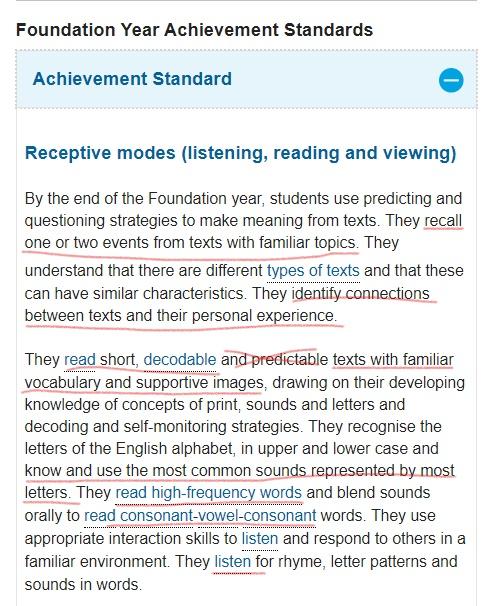
Top of the Rope
- I can recall one or two events from a familiar text.
- I can make a connection between myself and the texts I have read/had read to me.
Bottom of the rope
- I can read a short decodable text with vocabulary that I know and pictures that help me understand what it is about.
- I know the most common sounds for the alphabet (with automaticity).
- I can read a small number of irregular high frequency words (such as the, was, is, has).
- I can read CVC (consonant, vowel, consonant) words.
- I can listen for rhyme and letter patterns in words.
Let’s be clear, this is the Australian Curriculum expectation for the end of the first year of school. It isn’t my expectation or the expectation for any program that I know of. But, when we are reporting, the point isn’t that we are applying our own opinions, but rather assessing against the achievement standard. Each school will have its own way to wrestle with this conflict. And let’s be clear, there IS going to be ambiguity and conflict of expectations between the curriculum and your school’s approach, so just accept it. Railing against how silly it all is wastes useful energy.
The Foundation standard is, at least, fairly clear in its expectations, with the exception of a few things.
Questions to answer
- What is a short decodable text for foundation?

- Are you going to stick with the ‘most common’ or insist on all letter/sound correspondences? (I’d insist on all)
- How many irregular high frequency words are we talking about? (ideally, just those they need to read their short decodable texts)
- What phonological and phonemic awareness checkpoints will you aim for? (After all, you can’t read words if you can’t blend)
Year 1
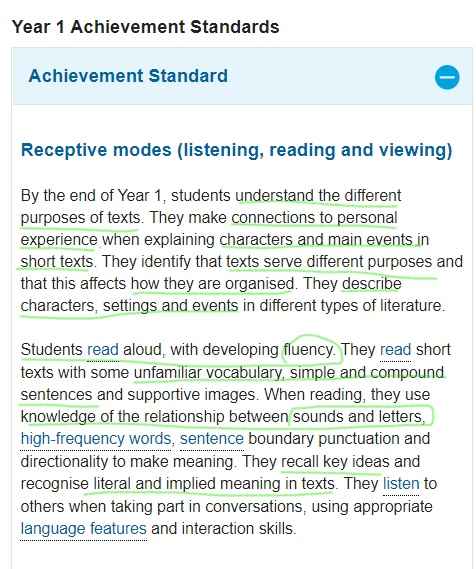
Top of the rope – Use a rich picture book in whole class lessons as the stimulus
- I can explain the different purposes of texts. (make this a Semester 1 focus)
- I can make a connection between my own experience to explain characters and events in short texts
- I can explain that texts are arranged in certain ways depending on their purpose. (Semester 2 focus)
- I can describe the characters, settings and events in different types of stories.
Bottom of the rope – student’s own reading
- I can read aloud with fluency.
- I can read decodable texts that have both simple and compound sentences.
- I use my knowledge of phonics and irregular high frequency words to read words.
- I use punctuation to help me understand the text. (Capitals and full stops)
- I can recall key ideas from the texts I read.
- I can answer a variety of questions about the texts I read.
When we get to year 1, things require a little more interpretation to make clear decisions. It would be really easy for the wheels to fall off here, so let’s look at some of the questions that your team has to be clear about when grading at the end of year 1.
Questions to Answer
What level of fluency are we looking for?

Fluency Is about so much more than a number, however it is a useful starting point. The above table comes from this terrific document from Edith Cowan University. This document also has information about the other aspects of fluency we need to consider such as phrasing and expression.
Which decodable texts are we looking for?
Firstly, there has to be at least 60 words in the texts for the student to have reached the fluency goal, but really, you are looking for something more complex.

This example from Read Write Inc would fit the bill.
I use my knowledge of phonics and irregular high frequency words to read words.
How much phonics knowledge are you looking for students to have by the end of the year? How does this align with your school’s program? How much phonics knowledge would be needed for the student to read the above text?
Which irregular high frequency words are needed for students to access the texts you want them to read?
Where do the questions come from? What kind of questions are you looking for?
Many decodable texts have questions included, but if yours don’t, you can formulate questions according to the Blanks framework.
This useful document can help you decide.
Year 2
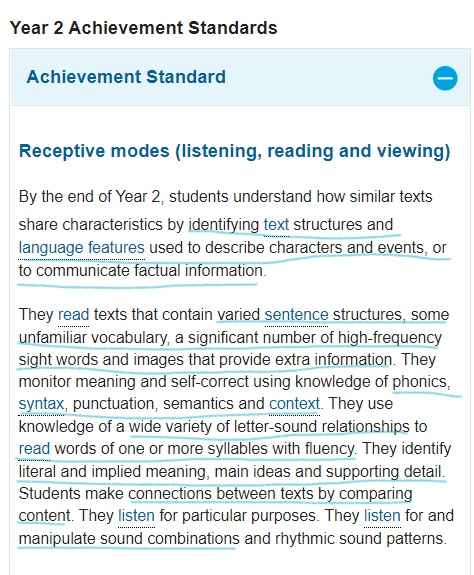
Top of the Rope (From rich picture books)
- I can list the text structures and language features that I can use to describe characters and events.
- I can create connections between texts by comparing the content of the text.
Bottom of the rope (Students own reading)
- I read books with simple, compound and complex sentence structures.
- I can read words in books that I don’t know well.
- I use the pictures/images that help me understanding more about what I am reading.
- I can recognise when what I have read doesn’t make sense and can fix it up sounding out words and using punctuation.
- I can read multisyllable words.
-
I can answer a variety of questions about the texts I read.
Questions to Answer
Even though fluency doesn’t appear as a point in the year 2 achievement standard, it has to be a factor.

What level of text complexity are we looking for?
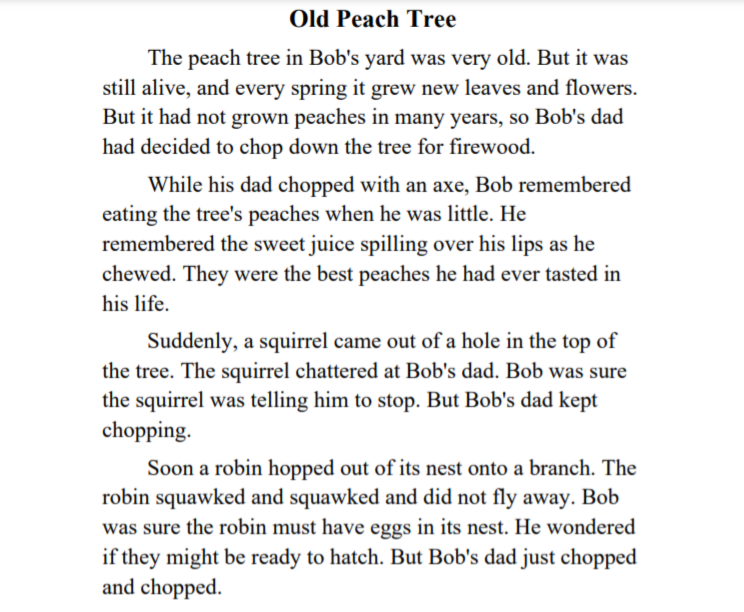
This passage from the DIBELS assessment shows what we are looking for. DIBELS is freely available and you can access it here.
What other information do we need about multisyllable words?
The key here is morphology and etymology. Students need to know how to read and spelling with common prefixes and suffixes in order to read multisyllable words. When you are assessing this point, pay attention to the words they get stuck on (often the multisyllable words). This will help you identify the next teaching points.
Step 2 - Decide on your ‘milestones’ throughout the year.
Once you know what you are looking for at the end of the school year, you can work backwards and figure out what you are looking for in the middle of the school year.
If you simply don’t have time to do all this mapping, ask yourself whether the student is on track to achieve the goals by the end of the school year.
If the answer is ‘yes’, the student may be a ‘C’. If the answer is no, ‘the student will be at a D or E’. If the student can already do all of the things, ‘they may be an A or a B’.
I have said ‘may’ because there are other factors to take into consideration when assigning grades.
Step 3 – Considering the other aspects of grading.
Finally, it is necessary to consider the circumstances the student can perform the skill in and how much support they need to do so.
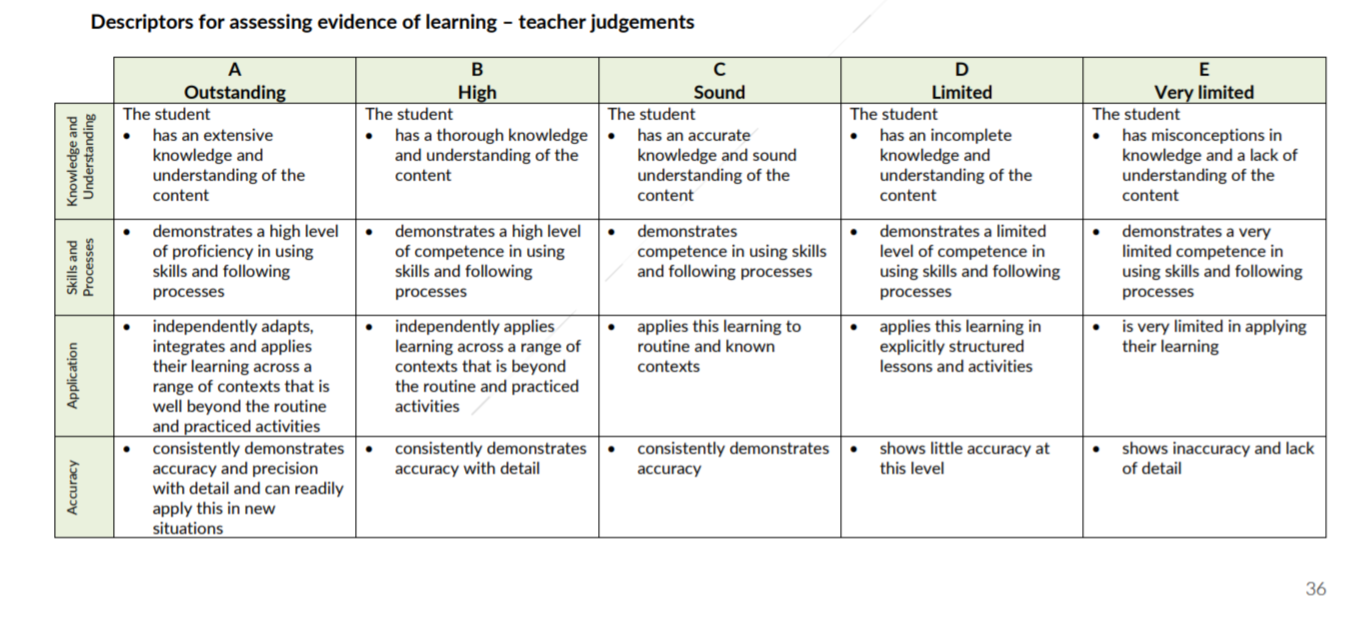
The above table (that you can find here) provides a useful description of the grades. We are used to the language of the knowledge and understanding and skills and processes rows, but the bottom two rows can really help understand the nuance of the grades.
A final way to think about the grading is how much support the student needs to perform the skill.
For example, if a student could sound out words in the context of your phonics lesson, but was unable to do it independently in their own reading, the grade would have to be a D. However, if they could take what you had taught and applied the knowledge to read unfamiliar words in their own independent reading outside the instructional contexts, the grade might be an B. If they then took what you taught about morphology and etymology and were reading complex scientific texts, the grade might be an A. Again, I say might, because of the expectations of different grade levels.
In Conclusion
Grading is a confluence of a number of ‘moving parts’. Hopefully, your school has nutted out the issues, but if not, use the above information to make an on-balance judgement using the following criteria:
- Whether the student is on track to achieve the desired skills by the end of the year
- How structured the task needs to be for them to perform the skills
- How far they can take the skill on their own to apply to new situations
- How many assessment opportunities you have to cross-reference your judgements
Remember, there will likely be a difference between what the curriculum expects and what your school’s program expects, although this is more pronounced in the Foundation year.
I wish you all the best of luck as you finalise reporting and hope that you are able to have a little rest soon.



4 comments
Brilliant Jocelyn! I asked this question on the fb page and again you have answered it simply and informatively! You are a gem.
Great post!
Kind regards
Hi Jocelyn,
Great article. It's always a tricky area, deciding on that C grade. The Year 1 curriculum extends to common long vowels, so my thought is that the passage should at least contain some common long vowels, depending on the phonics program the school is using.
Happy reporting everyone!
Leave a comment